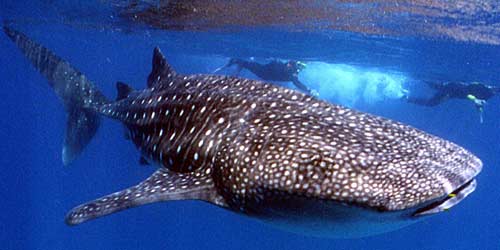Key Takeaways:
Zaven Arzoumanian, an astrophysicist at the Universities Space Research Association and NASA’s Goddard Space Flight Center in Maryland, thinks a whale shark’s spots can help save its skin. Along with Jason Holmberg, a U.S. software specialist, and Brad Norman, a marine biologist at Australia’s Centre for Fish and Fisheries Research, Arzoumanian applied an astronomical technique for “fingerprinting” whale sharks based on their skin’s spot patterns.
“This is an example of space technology finding an important application here on Earth,” Arzoumanian says.
Whale sharks, the world’s largest fish, are born with unique spotted skin patterns. Because the patterns don’t change significantly as the animals age, biologists can track specific animals just by studying images of them. In 1999, Norman established a photo library for sharks at Ningaloo Reef in Western Australia and visually looked for characteristics identifying individuals. This followed similar projects using photographs for identifying individual whales by their tail flukes, or dolphins by the shape and coloring of their fins.
But with large image libraries now available, manual identification is no longer feasible. Biologists need computer programs that can scan large databases accurately and efficiently.
As it turns out, a computational procedure developed to help astronomers sort out objects in images lends itself well to recognizing whale sharks. Identifying and precisely locating objects in a pair of astronomical images isn’t necessarily an easy task. An image may be rotated, magnified, or inverted relative to another. But the positions of objects common to both images reveal their underlying relationship, and it’s the sort of task a computer can perform.
“The contrast of white whale-shark spots on darker skin is well suited to a machine vision technique known as ‘blob extraction,’ which measures the locations and dimensions of pixel groups of a single color,” Arzoumanian explains. After processing the images for blob extraction, the team’s software looks for specific patterns. The pattern-recognition technique, developed in 1986, is included in software astronomers use to analyze data from the Hubble Space Telescope. “The spatial relationships between these groups … form the basis for a unique identifier for each shark.”
The authors set up the ECOCEAN Whale Shark Photo-identification Library with their own time and resources. The library acts as a single repository for whale-shark photographs taken by divers, tourists, and researchers. “The implications of this computer-aided identification technique and web-based photo library for management and conservation of whale sharks may be profound,” Norman says. The scientists describe their work in a Journal of Applied Ecology article published online September 28; it will appear in a forthcoming issue of the print journal.
The whale shark is the world’s largest fish, growing 65 feet (20 meters) in length and weighing more than 15 tons. Found in tropical waters around the globe, the whale shark is a harmless animal that lives off plankton, shrimp, and small fish. But it’s a culinary prize in Asia, where its meat (it’s said to taste like tofu) graces many menus and its fins are served in shark-fin soup. Marine biologists aren’t sure how many whale sharks there are, or how long they live.
The World Conservation Union lists the animal as “vulnerable to extinction.” But without knowing more about migrating species like the whale shark, it’s impossible to know if conservation efforts should be directed locally or internationally, or whether marine reserves designed to protect them are doing the job.










